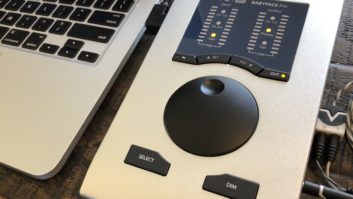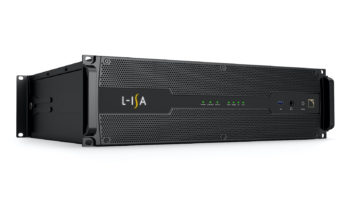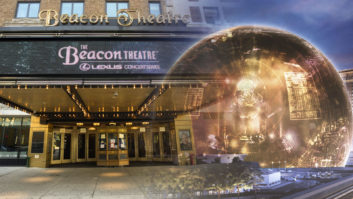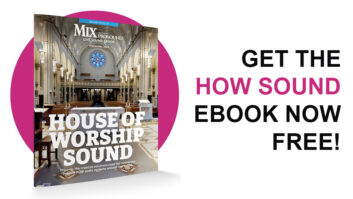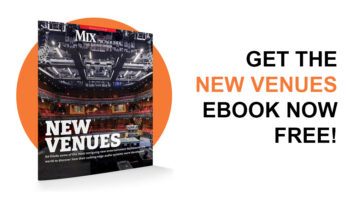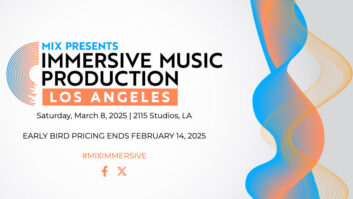
Los Angeles, CA—For years, visuals have been the focus of Tool’s live shows, the band disappearing into the shadows as it essentially creates a soundtrack to the video, laser and light displays. Those elements have constantly evolved over the years, says Liam Halpin, the band’s system tech since 2015, “but there’s not really been any developments with the audio.” Until recently, anyway.
Late last year, as fans eagerly awaited the release of Tool’s first new album in 13 years, Fear Inoculum, Halpin and FOH engineer Alan “Nobby” Hopkinson introduced an overhead speaker system to add an extra dimension to the art-metal band’s soundscapes. “I wanted it to be psychedelic, random movements that caught people out,” says Hopkinson, who has worked with the band for 20 years. “We just wanted to make the experience larger.”
“We refer to it as the effects P.A.,” says Halpin, who rejected the new generation of spatial sound systems, which require five or more speaker hangs across the stage, in favor of custom-designing a rig that would not obstruct sightlines. “The whole point of an immersive system is to enhance the show for the majority of the audience,” he says. “But how do you do surround sound for the upper bowl of an arena?”

Inspired by the Dolby Atmos system he had installed at home, Halpin continues, “What I came up with were traditional left-right surround hangs that would fly in the lower bowl, toward the rear of the arena, and fire back toward the stage. To add the height dimension, we’ve got seven cabinets of d&b audiotechnik V-Series firing from the middle of the arena either side of the ice rink to cover the back half of the lower bowl to about where front-of-house is. Directly behind those, closer to the stage, is another hang, flown off two frames so that I can get a lot of down-tilt. That covers from the front edge of the stage to the middle of the arena,” he says.
But how to also give the upper bowl an enhanced experience? “The two ceiling hangs are each flown off a single piece of truss, on the center line, so I came up with the idea of having a side-firing hang flown from the same truss. Two more hangs on the back corners of the ice rink cover the rear section of the upper bowl and the section behind the surround hangs.”
The main mix is delivered through left-right arrays of d&b GSL cabinets with KSL side hangs. A third hang per side, of V-Series, enables Halpin to deliver more even coverage without overtaxing the side hangs. Arrays of SL-Subs are flown behind the main and side hangs.
“By kicking the subs out at 45 degrees, I minimize the amount of interference between the hangs, and it gives me almost a zero delay time. By making the subs the zero point, I’ve allowed a greater degree of control over the tonal balance throughout the arena,” says Halpin.
“Nobby is the engineer who decides how Tool sounds. My job is to make it sound the same in every seat.”
Production provider Eighth Day Sound is supporting the world tour from its network of locations in the United States, Europe and Australia.
To control the positioning and panning of sources in the effects P.A., Halpin called on an old friend, Dave Haydon, director and co-owner of OutBoard Electronics, manufacturer of TiMax live sound products. OutBoard supplied Eighth Day with a TiMax SoundHub-S64, which supports 64×64 I/O on Dante, with analog and AES outputs offering redundancy.
“The room spatialization mapping was rendered by dropping the multichannel loudspeaker locations onto a TiMax PanSpace map, then creating TiMax Image Definition objects comprising combinations of the relevant speakers with levels and delays set to allow placement or panning of the sound at or between the required 3D locations,” Haydon explains. “Spatial events were programmed in the PanSpace Spatialization window either as Cues to be triggered manually, or remotely from stage via MIDI, or set up as live, real-time 3D pans for over 20 mix channels to be controlled at FOH by Liam, using TouchOSC on iPads driving the TiMax software’s OSC port.”
During a show, Halpin mixes selected elements on a digital Midas Pro2 console into the effects P.A., while Nobby handles the main house mix on an analog Midas XL4. “The first few shows, I was doing all the movement myself, other than some things we programmed that were always going to be the same,” says Nobby. “Then it became obvious I couldn’t do both. It’s too much.”
Live Sound Showcase: Ghost’s Tour of Death, by Strother Bullins, Jan. 30, 2019

As the tour progresses, Halpin is now sending elements to the effects P.A. throughout the show. “We experiment with it every day,” Nobby says, and no two shows are alike anyway, as the band improvises many sections.
“There’s no timecode and no tracks,” adds Halpin. “Everything is played live,” and always has been.
Effects P.A. sources are a combination of the digital split from the stagebox and direct outputs from the XL4 via Ferrofish Dante converters (which also feed dual-redundant multitrack recorders that archive every show). Additionally, certain samples triggered by drummer Danny Carey, sent to the XL4 as a two-channel submix, are split out at the stage and fed individually to the Pro2. “This is a perfect example of how you can take something that starts off as a standard left-right P.A. in an arena and it becomes hugely flexible through the advantages of audio-over-IP networking,” says Halpin.
Live Sound Showcase: Godsmack Tour Serves Up ‘Legends Live,’ by Clive Young, Jan. 7, 2020
“We have a few auxes that come off the XL4 that feed into the Pro2,” he adds, including some of Nobby’s reverbs and delays, which he can dynamically move through the arena. “They extend out from the main system and become a huge moment in the room.”
The pair were unable to guarantee how well the system would work until they tried it in an arena, but the band and their production team were prepared to roll the dice. “It was a gamble, but it’s paid off,” says Nobby, noting that the production was willing to underwrite the additional expense. “We had to get extra crew on board,” he says. The rigging call is now 4:30 a.m., and on tight overnighters, the riggers are flown ahead to the next venue, he adds.
Nobby originally planned to use the effects P.A. only on the initial U.S. leg following the album release, “but now we’re taking it everywhere,” he says, including the upcoming run in Australia and New Zealand.
“The band made that call. That’s rewarding.”
Eighth Day Sound • www.8thdaysound.com
